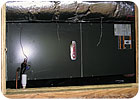
This Rheem unitary dual-fuel, gas heating-heat pump combination system is replacing a Rheem gas pack that had been at the home for about 18 years, said Robbie Hill, president of Hill’s Service.
Robbie Hill took over for his father, Robert Hill Sr., as president of the company in 1993. You could say that the younger Hill grew up with heat pumps. The technology, he is quick to point out, has come a long way since those early installations. Still, customers’ memories can color their perceptions for a long time. Those early systems had their problems.
“Customers all seem to want extended warranties on all these new systems,” Hill said. “They’re getting more cutting-edge technology, but they’re afraid there are more things to go wrong. And they’re skeptical about the heat pump; they always heard it was cool in the heating mode.”
Hill makes sure they understand that today’s variable-speed systems make the “cold blow” problem a thing of the past. “Just make sure you’re using the variable-speed air handler and make sure it has a chance to get some heat. They have time to gather heat in the airstream.”
HEAT PUMP INSTALLS
The company has done enough heat pump and air conditioner installations to know where the pitfalls lie. WhenThe NEWScaught up with Hill, the contractor had several heat pump installations going on at the time. One was a Rheem unitary dual-fuel, gas heating-heat pump combination with 14 SEER efficiency and MERV 11 filtration.“A Rheem gas pack had been in that home for about 18 years,” Hill said. “And before that there was an oil split furnace with no air conditioning.” The old cooling system had about a 9 SEER efficiency, he said.
Hill often refers to the property and its history of mechanical systems more often than he talks about the current owner. Often the contractor has had a long-term relationship with the structure, although it may have changed hands a few times. This particular home is a 1,400- to 1,500-square-foot residence with a brick veneer. The package unit was a crawl space installation, which is typical for the area, but which requires certain precautions to prevent moisture and mold incursion (i.e., laying heavy-gauge plastic down to seal the ground).
There is no duct board in this home’s air-handling system, Hill said. It’s all sheet metal. “We’re reinsulating it with R6 insulation, taking out failed mastic and duct tape, and sealing the system back up.” It’s part of the company’s holistic approach to installations.
“You have to use a holistic approach,” Hill said. “You can’t leave anything out. All those things (sealed ductwork, correct sizing, correct charging) work together.”
The contractor performs load calculations “every time, room-by-room.” Even though his company may be familiar with the home, “The owners probably have changed that house from the last time you were there,” he said.
It’s also important to make sure proper calculations are made when customers get a system with a different refrigerant. “With the R-410A systems, we’re dealing with a different split from the latent to the sensible load,” Hill explained. In this humid climate, reducing the size of the variable-speed air handler helps the system dehumidify better; it runs longer and removes more moisture as a result.
This home also is using a Honeywell fresh air ventilator. “We’re able to manage how much ventilation there is, instead of arbitrarily ventilating the home,” Hill said. It’s another good reason to make sure ductwork leaks have been repaired as much as possible.

Hill’s Service replaced most of the ductwork out of a very large, Italian villa-type home because it was too leaky. The new, 19 SEER Lennox split heat pump needs the correct airflow in order to provide the type of operation and efficiency the customer expects.
BIG DUCT REPLACEMENT
In another heat pump job going on at the same time, Hill’s Service was taking all the ductwork out of a very large, Italian villa-type home. “It was too leaky as it was,” Hill said. “We’re taking out flex; it’s a whole hodgepodge system with all kinds of problems.”The new system is a 19 SEER Lennox split heat pump that also will better meet the family’s IAQ demands. It includes a UV system, fresh air makeup, and MERV 17 filters. “All the statistics that I can find say that 80 percent of our problems are airflow problems,” Hill commented. “It’s the ductwork itself. If it doesn’t breathe efficiently, it doesn’t cool or heat efficiently. And if you don’t size it right, it can’t work right.”
If the system is oversized to compensate for poor airflow, “You’re trying to hide sins with things other than what you’re supposed to be doing.”
This contractor knows that sooner or later his company will probably return to these properties to work on their mechanical systems. He also knows that it’s better to come back because you did the right things, not the wrong ones.
SIDEBAR: HILL'S SERVICE
Robert Hill Sr. founded Hill’s Service Co. in May of 1965. With $5,000, Hill Sr. purchased a service department, truck, tools, parts, and a customer list, and began his own heating and air business. With slow but steady growth, Hill’s Service now has 17 employees and 11 trucks.In 1977, the business began to work on commercial refrigeration equipment. In 1996, duct cleaning was added and received a tremendous response from customers. Today, the company provides residential and commercial heating and air conditioning, commercial refrigeration, ice machines, duct cleaning, digital controls, and zoning systems.
In 1993, Robbie Hill Jr. was named president and Michael (Buddy) Hill was named vice president-secretary-treasurer.
Publication date:05/28/2007

Report Abusive Comment